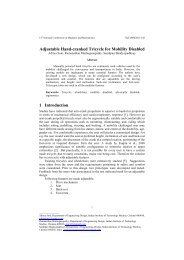Shortest path in a multiply-connected domain having curved ...
Shortest path in a multiply-connected domain having curved ...
Shortest path in a multiply-connected domain having curved ...
You also want an ePaper? Increase the reach of your titles
YUMPU automatically turns print PDFs into web optimized ePapers that Google loves.
E<br />
S<br />
(a) Sample set of curves (b) PCTs that are<br />
completely conta<strong>in</strong>ed <strong>in</strong><br />
MCD<br />
Figure 2: Sample set of curves and PCTs from S<br />
(the footpo<strong>in</strong>t denoted as T ). Let CF E denote the curve at which the extended PCT <strong>in</strong>tersects<br />
first, with the <strong>in</strong>tersection po<strong>in</strong>t denoted as IF E. Also, let IOC be the first <strong>in</strong>tersection of the<br />
PCT with the outer curve COC. It is to be noted that the extended PCT can <strong>in</strong>tersect the<br />
outer curve first and <strong>in</strong> that case, CF E = COC, and IF E = IOC.<br />
4.1 Process<strong>in</strong>g PCTs<br />
Initially, PCTs from S (us<strong>in</strong>g constra<strong>in</strong>t equation <strong>in</strong> [18]) are used as the start<strong>in</strong>g tangents.<br />
All the PCTs that are not completely conta<strong>in</strong>ed <strong>in</strong> the MCD are then removed (Figure 2(b)<br />
shows only PCTs that are completely conta<strong>in</strong>ed <strong>in</strong> the MCD). Consider<strong>in</strong>g the Figure 3(a),<br />
for the PCT ST1, the curve C1 is CT G which has the footpo<strong>in</strong>t T1. The extended PCT first<br />
<strong>in</strong>tersects at P1. Hence IF E = P1. S<strong>in</strong>ce P1 is at the outer curve COC, IF E = IOC = P1<br />
and CF E = COC. Note that T1P1 is completely conta<strong>in</strong>ed <strong>in</strong> the MCD. For the extended<br />
PCT whose first <strong>in</strong>tersection IF E = I3 with curve CF E = C3, CT G = COC. However, for the<br />
extended PCT whose first <strong>in</strong>tersection IF E = I4 with curve CF E = C3, CT G = C5. All the<br />
extended portions of the PCTs are identified by dashed l<strong>in</strong>es.<br />
4.1.1 Exterior region identification<br />
Among the PCTs that are completely conta<strong>in</strong>ed <strong>in</strong> MCD, a PCT with its footpo<strong>in</strong>t T or IF E<br />
ly<strong>in</strong>g on COC, the closest <strong>in</strong> clockwise direction along the curve COC to the end po<strong>in</strong>t, E, is<br />
selected. Though the search is done <strong>in</strong> clockwise direction, the closest po<strong>in</strong>t (for example,<br />
P3 <strong>in</strong> Figure 3(a)) is <strong>in</strong> the counter-clockwise portion between S and E, when travelled from<br />
S. Hence the PCT is named as CCRP CT (counter-clockwise region PCT). For a PCTs thus<br />
selected, the follow<strong>in</strong>g regions are described based on the conditions del<strong>in</strong>eated as follows.<br />
1. If CT G and CF E are both COC respectively, then two regions are identified. One region<br />
consist<strong>in</strong>g ST and portion of outer curve from T to S (that does not conta<strong>in</strong> E) as<br />
6<br />
S




